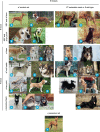Comprehensive genetic testing combined with citizen science reveals a recently characterized ancient MC1R mutation associated with partial recessive red phenotypes in dog
- PMID: 33292722
- PMCID: PMC7643265
- DOI: 10.1186/s40575-020-00095-7
Comprehensive genetic testing combined with citizen science reveals a recently characterized ancient MC1R mutation associated with partial recessive red phenotypes in dog
Abstract
Background: The Melanocortin 1 Receptor (MC1R) plays a central role in regulation of coat color determination in various species and is commonly referred to as the "E (extension) Locus". Allelic variation of the MC1R gene is associated with coat color phenotypes EM (melanistic mask), EG (grizzle/domino) and e1-3 (recessive red) in dogs. In addition, a previous study of archeological dog specimens over 10,000 years of age identified a variant p.R301C in the MC1R gene that may have influenced coat color of early dogs.
Results: Commercial genotyping of 11,750 dog samples showed the R301C variant of the MC1R gene was present in 35 breeds or breed varieties, at an allele frequency of 1.5% in the tested population. We detected no linkage disequilibrium between R301C and other tested alleles of the E locus. Based on current convention we propose that R301C should be considered a novel allele of the E locus, which we have termed eA for "e ancient red". Phenotype analysis of owner-provided dog pictures reveals that the eA allele has an impact on coat color and is recessive to wild type E and dominant to the e alleles. In dominant black (KB/*) dogs it can prevent the phenotypic expression of the K locus, and the expressed coat color is solely determined by the A locus. In the absence of dominant black, eA/eA and eA/e genotypes result in the coat color patterns referred to in their respective breed communities as domino in Alaskan Malamute and other Spitz breeds, grizzle in Chihuahua, and pied in Beagle.
Conclusions: This study demonstrates a large genotype screening effort to identify the frequency and distribution of the MC1R R301C variant, one of the earliest mutations captured by canine domestication, and citizen science empowered characterization of its impact on coat color.
Keywords: Ancient; Canine; Coat color; Dog; Domino; Eumelanin; Grizzle; MC1R; Pheomelanin; Reduced-function variant.
Conflict of interest statement
HA, LH, PR, JM and JD are employees of Wisdom Health that offers canine DNA testing as a commercial service.
Figures



Similar articles
-
Canine coat color E locus updates: Identification of a new MC1R variant causing 'sable' coat color in English Cocker Spaniels and a proposed update to the E locus dominance hierarchy.Anim Genet. 2024 Apr;55(2):291-295. doi: 10.1111/age.13398. Epub 2024 Jan 29. Anim Genet. 2024. PMID: 38282569
-
Evidence of coat color variation sheds new light on ancient canids.PLoS One. 2013 Oct 2;8(10):e75110. doi: 10.1371/journal.pone.0075110. eCollection 2013. PLoS One. 2013. PMID: 24098367 Free PMC article.
-
A new mutation in MC1R explains a coat color phenotype in 2 "old" breeds: Saluki and Afghan hound.J Hered. 2010 Sep-Oct;101(5):644-9. doi: 10.1093/jhered/esq061. Epub 2010 Jun 4. J Hered. 2010. PMID: 20525767
-
Melanocortin-1 receptor mutations and pigmentation: Insights from large animals.Prog Mol Biol Transl Sci. 2022;189(1):179-213. doi: 10.1016/bs.pmbts.2022.03.001. Epub 2022 Mar 25. Prog Mol Biol Transl Sci. 2022. PMID: 35595349 Review.
-
Melanocortin receptor variants with phenotypic effects in horse, pig, and chicken.Ann N Y Acad Sci. 2003 Jun;994:313-8. doi: 10.1111/j.1749-6632.2003.tb03195.x. Ann N Y Acad Sci. 2003. PMID: 12851331 Review.
Cited by
-
Towards Forensic DNA Phenotyping for Predicting Visible Traits in Dogs.Genes (Basel). 2021 Jun 11;12(6):908. doi: 10.3390/genes12060908. Genes (Basel). 2021. PMID: 34208207 Free PMC article.
-
ASIP Promoter Variants Predict the Sesame Coat Color in Shiba Inu Dogs.Vet Sci. 2022 May 3;9(5):222. doi: 10.3390/vetsci9050222. Vet Sci. 2022. PMID: 35622750 Free PMC article.
-
Comparative genomics of Balto, a famous historic dog, captures lost diversity of 1920s sled dogs.Science. 2023 Apr 28;380(6643):eabn5887. doi: 10.1126/science.abn5887. Epub 2023 Apr 28. Science. 2023. PMID: 37104591 Free PMC article.
-
The Shepherd and the Hunter: A Genomic Comparison of Italian Dog Breeds.Animals (Basel). 2023 Jul 27;13(15):2438. doi: 10.3390/ani13152438. Animals (Basel). 2023. PMID: 37570247 Free PMC article.
References
-
- Dürig N, Letko A, Lepori V, Hadji Rasouliha S, Loechel R, Kehl A, et al. Two MC1R loss-of-function alleles in cream-coloured Australian Cattle Dogs and white Huskies. Anim Genet. 2018;49(4):284–290. - PubMed
-
- Newton JM, Wilkie AL, He L, Jordan SA, Metallinos DL, Holmes NG, et al. Melanocortin 1 receptor variation in the domestic dog. Mamm Genome. 2000;11(1):24–30. - PubMed
-
- Dreger DL, Schmutz SM. A new mutation in MC1R explains a coat color phenotype in 2 “old” breeds: Saluki and Afghan Hound. J Hered. 2010;101(5):644–649. - PubMed
-
- Schmutz SM, Berryere TG, Ellinwood NM, Kerns JA, Barsh GS. MCIR Studies in Dogs with Melanistic Mask or Brindle Patterns. J Hered. 2003;94(1):69–73. - PubMed
-
- Everts RE, Rothuizen J, Van Oost BA. Identification of a premature stop codon in the melanocyte-stimulating hormone receptor gene (MC1R) in Labrador and Golden retrievers with yellow coat colour. Anim Genet. 2000;31(3):194–199. - PubMed
LinkOut - more resources
Full Text Sources
